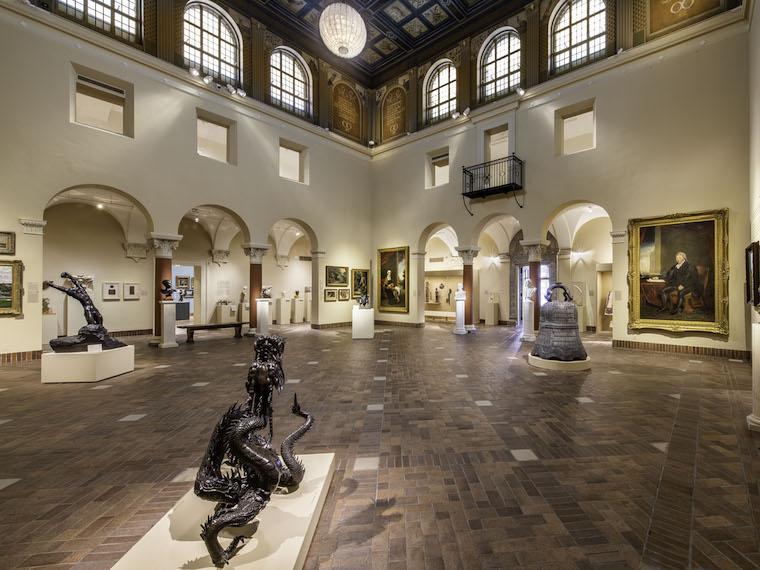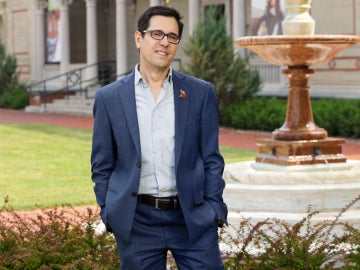Use the Allen App to see—and hear about—works of art as never before
June 23, 2021
Megan Harding

Photo credit: Kevin G. Reeves
Imagine encountering the large Coiling Dragon upon entering the museum and using your cell phone to hear a musical composition inspired by the bronze sculpture, or to hear the label translated into Mandarin Chinese. Well, now you can!
Launched over the summer, the Allen App is a new tool for museum visitors to learn about and experience the collection. The application is loaded with audio and visual content on more than 60 works of art.
“One of the things I like about the app is how it inspires collaboration with faculty and students in many different disciplines,” said Jill Greenwood, the AMAM’s Eric & Jane Nord Family Curator of Education. “Content for the app is just exploding,” she says, and new features are continually added to heighten interaction with works in the galleries. For example, a Chinese-language tour of 14 important works was translated and narrated by Jessie Yuan ’21, a curatorial assistant funded by the Freeman Asian Arts & Culture Initiative.
As a senior project, Leina Fieleke ’21 created a Composers’ Tour in collaboration with Oberlin Conservatory students, each of whom composed a musical interpretation of a particular artwork in the collection. In the Allen App, recordings of the music being performed by conservatory students are paired with other content about these works. The easy-to-navigate application allows users to choose a highlights tour, a tour by gallery, or a tour of the special exhibition Mobility and Exchange, 1600–1800.
One reason the Education Department opted to build an app—a replacement for the audio wands previously available at the museum’s front desk—was to provide new ways for people with sensory impairments to access the collection. The Allen App has high-verbal descriptions for dozens of works (with more to come). These narrations, intended for those with low or no vision, use nonvisual language to help people form mental images of what they cannot see. The decision to build an app that visitors can use on their own cell phones has another advantage: visitors with vision or hearing loss often carry devices already adapted to meet their specific needs. A tablet also will be available, upon advance request.
Efforts to develop an app accelerated due to the pandemic; a no-touch audio tool became imperative. Liz Yearsley ’20, curatorial assistant in the Education Department, coordinated content from 20 different Oberlin students, creating a set of guidelines for writing and narrating the app’s high-verbal descriptions. She also narrated many of the sections herself and uploaded all of the content to STQRY, developer of the mobile tour platform.
At least one app entry came from each of the six students who participated in this year’s SOAR Internship in Museum Education: Biba Duffy-Boscagli, Gillian Ferguson, Fudi Fickenscher, Ursula Hudak, Natalie Ivy, and Alia Schreiber-Goldstein. All are from Oberlin’s class of 2023.
The Allen App is in the beta-testing phase, and we invite your feedback. Please visit allen.stqry.app to browse the application (preferably in the galleries), then email your comments to education.amam@oberlin.edu or complete the in-app survey.
You may also like…
Interview: Jon Seydl, John G.W. Cowles Director of the Allen Memorial Art Museum
Get to know Jon Seydl, the new John G.W. Cowles Director of the Allen Memorial Art Museum at Oberlin.
Oberlin College Names Jon Seydl as Director of the Allen Memorial Art Museum
Oberlin College and Conservatory is pleased to announce the appointment of Jon Seydl as the new John G. W. Cowles Director of the Allen Memorial Art Museum. He will begin his tenure on July 1.
Longtime Allen Memorial Art Museum Director Andria Derstine Announces Departure
After more than a decade of exemplary leadership, Andria Derstine is leaving her post as the John G. W. Cowles Director of the Allen Memorial Art Museum (AMAM) at Oberlin College


